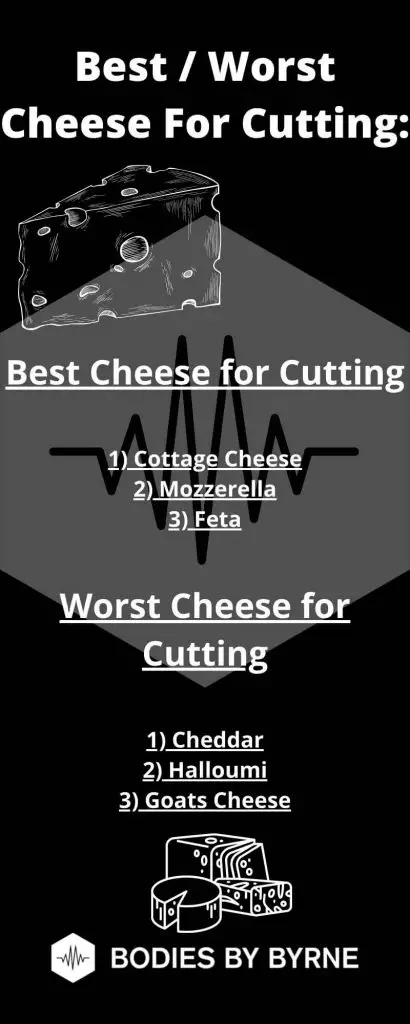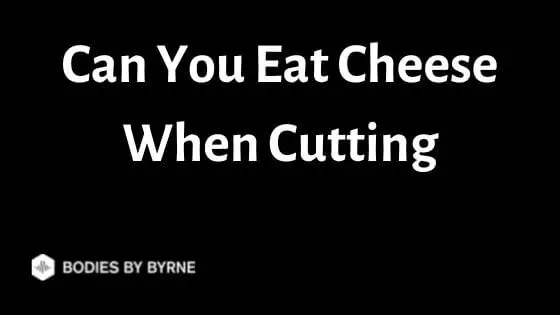Cutting is difficult. As you’re always keeping track of the number of calories you consume and constantly trying to maintain a deficit, your food choices are dramatically reduced.
As a widely popular food, we’re often asked whether or not you can eat cheese when cutting.
Overall, due to the high calorie and high-fat content cheese doesn’t lend itself well to cutting – regularly eating a lot of cheese will make it much harder to cut and could undermine the results you want to see.
However, does this mean that it’s impossible to eat cheese when cutting or is there a way to incorporate cheese into your diet when cutting?
Can You Eat Cheese When Cutting?
Many varieties of cheese are high in calories and high in fat. As a result of this high fat and calorie content, most people shouldn’t eat cheese when cutting as you’ll struggle to maintain your calorie target and stick to an overall caloric deficit.
What is Cheese?
Cheese is a food made up of proteins and fats. It usually comes from cow’s milk, although there are other sources of cheese available.
Cheese comes in hundreds of different types with a huge range of textures, flavors, and styles available to buy.
Due to the significant diversity in cheese available, it’s difficult to talk about it collectively as there’s wide variation in the nutrients it contains, as well as its calorie and fat content.
In general though, cheese offers many health benefits due to its high calcium content which is needed to support bone mass. It also contains a lot of vitamins, such as vitamin A and B12.
Also, cheese is a source of fat. Even when cutting you still need to include fat within your diet as it’s essential for bodily functions and overall health – particularly testosterone levels and an overall hormonal balance.
However, it’s important to consider what kind of fat cheese is made up of. Cheese is high in unsaturated fats. These kinds of fats have been linked to health issues such as heart disease and so it’s usually recommended that you don’t have a lot of these in your diet.
Overall then cheese does offer some health benefits, but also some potential downsides too. On balance, cheese shouldn’t form a significant part of your diet, especially when cutting, due to the high unsaturated fat and calorie content.
Cheese Calories
Per 100g, the nutritional value of these three popular kinds of cheese is:
| Cheddar | Mozzarella | Feta | |
| Calories (kcal) | 404 | 300 | 264 |
| Fat (g) | 33 | 20 | 21 |
| Carbs (g) | 1 | 4 | 4 |
| Protein (g) | 25 | 26 | 14 |
Cheese is calorie dense which means that per gram the calorie content is high in comparison to other foods. It’s also high in fat.
However, due to the variety of cheeses available the calorie and fat content varies significantly. Eating 100g of feta, for example, isn’t going to be as many calories as the same amount of cheddar or mozzarella.
How to Eat Cheese When Cutting

While cheese can be eaten on its own, most people have cheese with other foods. Due to the high-calorie content of cheese, this means that you’re adding a considerable amount of calories to any food you’re eating by adding cheese as a topping.
Related – Can you eat pasta when cutting
When cutting, it’s important to think about every calorie and ensure that you maintain a deficit.
So, if you can’t go without cheese then it’s essential that you account for it in your daily calorie intake. This will mean adjusting your diet and cutting calories from other areas in order to maintain an overall deficit.
In order to do this more easily, I recommend limiting your portion sizes. In the table above I’ve outlined the calorie content of 100g of different cheeses. But you could reduce this further and only have 50g of cheese as a topping.
You should also stick to lower calorie cheeses if you plan to eat cheese when cutting. The lowest calorie cheeses are parmesan, feta, and goat cheese. This way you don’t have a huge amount of calories to account for. As a result, cutting will be far easier.
Also, try to get lower-calorie versions. In most supermarkets there will be lower calorie options – look out for low-fat options of your favorite cheeses as these will be significantly lower in calories.
Something else to think about is when you’re incorporating cheese into your diet. If you’re adding it into a dish will you actually notice if you aren’t including it? If you’re not even tasting it when you include it in a meal then I recommend skipping the cheese and saving yourself those calories!
Perhaps the best way to consume cheese when cutting is to have cottage cheese. The macro profile of cottage cheese is great for supporting muscle growth (due to high protein) whilst also being relatively low in calories.
There’s a reason people consider this a staple food for bodybuilding and if you can fit it into your meal plan, it can be equally beneficial when cutting.
There are also other ways of satisfying your cravings for cheese, without the same calorie content. Check out the next section where I’ve discussed cheese alternatives you should consider when cutting.
Cheese Alternatives When Cutting
There isn’t a direct cheese replacement that’s low in calories and well suited for cutting. Low-calorie cheeses are still fairly high in calories. So you’ll have to look at other kinds of products for a suitable alternative.
One kind of alternative if you’re looking for something to replace cheese on nachos or chips is a low-calorie cheese sauce. This way you still get the same taste, without the same amount of calories.
The brand SkinnyFood in the UK has a variety of cheese sauce options available and these come in at virtually zero calories which makes them a suitable option when cutting.
** Alternatives are available in other countries, this was just an easy example to give.
Another option is a low-calorie spread. These are a good alternative if you’re used to eating cheese on toast and want something that’s lower in calories but will still taste good.
See also – Can you eat bread when cutting
The good news is that there’s a variety of low-calorie spreads available. To find low-calorie options focus on those that are vegetable-based and have a low oil and fat content.
Final thoughts
Cheese is a widely popular food. Although it has some health benefits, particularly due to its high calcium content, it’s also high in unsaturated fat and calorie dense.
When cutting you want foods that are going to leave you feeling fuller for longer, whilst being low in calories. Unfortunately, cheese is the opposite of that as it’s high in fat and in calories, and just a small amount can add a noticeable amount to your daily calorie intake.
This being said, if cheese is something you can’t go without then it’s best to focus on low-calorie cheeses, especially those with reduced fat content. It’s also best to cut back on the amount of cheese you’re eating.
Also, consider cheese alternatives like low-calorie cheese sauces and low-calorie spreads which provide flavor without packing the same amount of calories.
